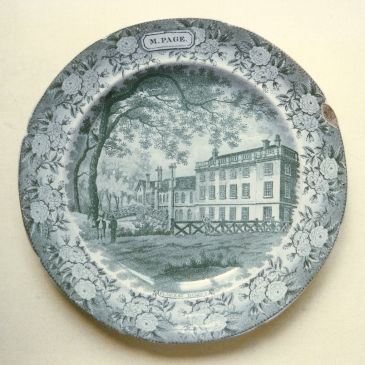In the 19th century, two classes of table crockery evolved, incorporating illustrations of Queens’ College.
1. Table crockery for use by the college itself
Before the advent of table crockery, general tableware for students and Fellows was made of wood platters or pewter, although cutlery, particularly for the Fellows, might have been made of silver. From the 1760s onwards, colleges began to change their tableware to crockery. Queens’ College apparently changed rather late, in 1842. At Cambridge, college crockery was normally owned by the college Cook (a sub-contractor), and such crockery was normally marked with the name of the Cook. Unusually for Cambridge, at Queens’ College it was the Porter who had care of the crockery, rather than the Cook. So early crockery at Queens’ was marked with the name of the Porter, not the Cook. Specimens are known inscribed “G. GERMANEY” for George Germaney, Porter 1825–46; and “M. PAGE” for Martin Page, Porter 1846–71.
The view of the college shown here is based on the print of Essex Building and the river frontage, by Richard Bankes Harraden, first published around 1809–11, and re-published in 1830. This photograph was provided by alumnus Tim Gossling (matric. 1955).
In the modern period, college crockery, if marked, is marked with the boar’s head badge, and very little else.
2. Table crockery for general sale
From the 1830s onwards, the Staffordshire pottery of Charles James Mason marketed tableware (branded Ironstone China) decorated with views of Cambridge colleges. They were decorated by a transfer process, permitting a single colour against the background off-white of the ironstone: such pottery was referred to as “transferware”. The border was usually a “Garden Trellis” design, and the central view would be based on one of the popular prints of the period. After the bankruptcy in 1844 of C.J. Mason, successor companies continued to market the same designs for many decades. It appears not to be possible to attribute dates to individual specimens, or even to identify which company made them.
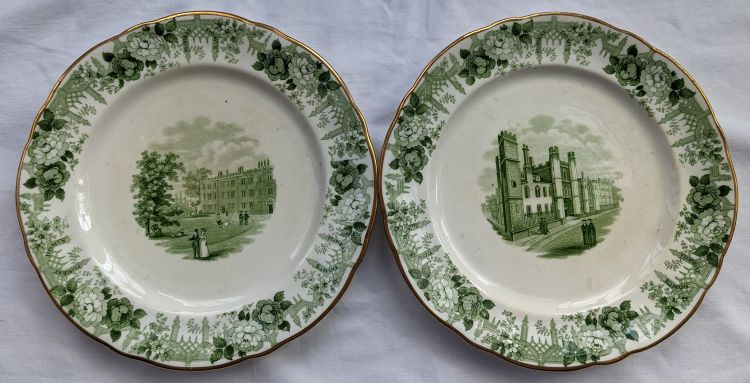 The crockery that featured views of Queens’ College used green transfers, and incorporated the college motto “FLOREAT DOMUS” in the trellis border. Two views of Queens’ College were used in these designs, based on prints:
The crockery that featured views of Queens’ College used green transfers, and incorporated the college motto “FLOREAT DOMUS” in the trellis border. Two views of Queens’ College were used in these designs, based on prints:
- the Walnut Tree Building, by James Storer and Henry Sargant Storer. Published in a part form series 1827–1829.
- the Queens’ Lane frontage, by Richard Bankes Harraden. The print is dated 1824, and was first published in 1830.
Those publication dates establish the earliest possible date for the transfers to have been made.
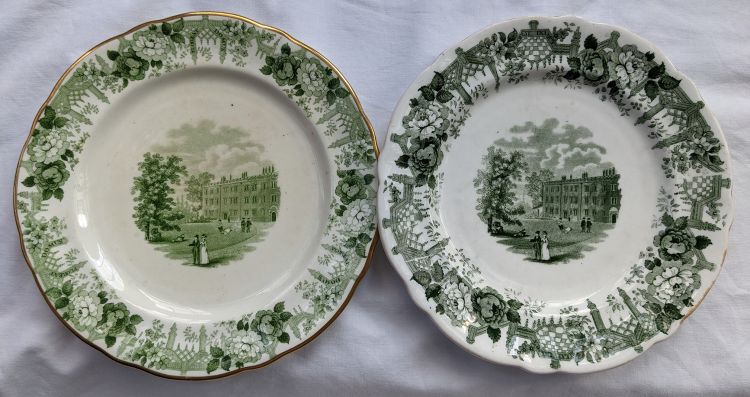 There were two designs for quoting the motto in the trellis border.
There were two designs for quoting the motto in the trellis border.
The left-hand design incorporated the motto in a solid part of the trellis.
The right-hand design incoporated the motto behind a chequer-board in the trellis.
Apparently, Queens’ was the only college in this range of crockery which had its motto included.
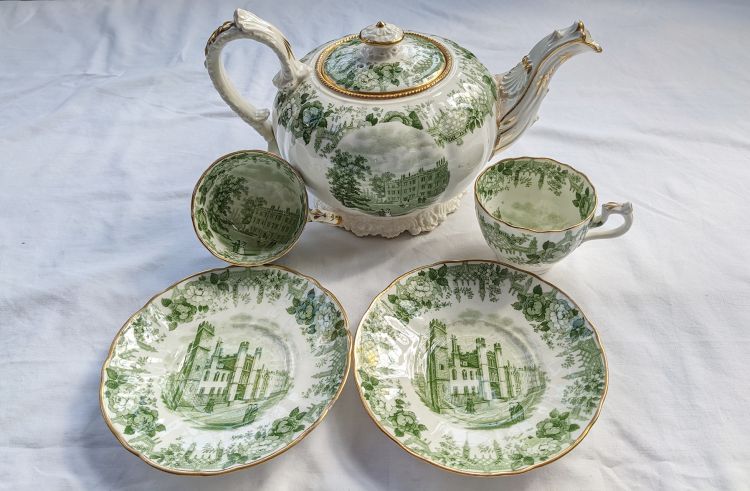 A small selection from a tea-set containing many varied items, but all decorated with the same transfers as the plates above.
A small selection from a tea-set containing many varied items, but all decorated with the same transfers as the plates above.
The tea-pot has both views of college, one on each side.
The right-hand tea-cup has both versions of motto design, one on the outside, and one on the inside.
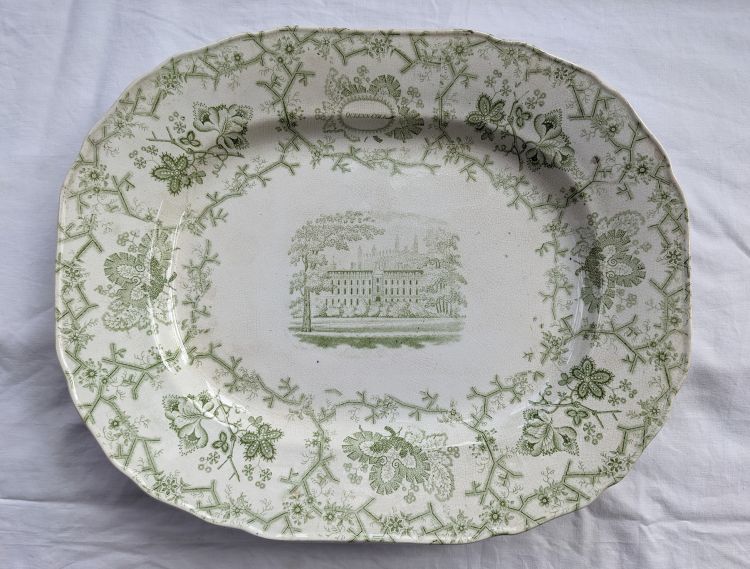 An example of a terrible error from a different range of ironstone china.
An example of a terrible error from a different range of ironstone china.
This serving platter is labelled “Queens Coll”, but the view in the centre is of the back of Clare College, based on a print by William Mason, around 1823.
This general design was known as “coral border”. It was probably made by the company of Thomas Dimmock (Jnr) & Co.
References and Further Reading
1999: 19th-century Cambridge College Ceramics and a Comparison with Oxford Colleges, by Peter George Ingle Stovin (1925–2014), in Journal of the Northern Ceramic Society 16:51–71. (ISSN 0969-7381)
2012: Queens’ College Plates at Brook Farm, Haslingfield, by Cambridge Archaeology Field Group.
2016: Cambridge College Ceramics c. 1760–1900: a brief overview, by Craig Cessford, in Proceedings of the Cambridge Antiquarian Society, Vol. 105, pp. 109–126. (ISSN 0309-3606)
2016: The Transferware Recorder : Number 3 : Selected British Views, by Richard K. Henrywood, pp. 91–96. (ISBN 978-0-9926581-2-0)
2017: Cambridge colleges and their crockery, from the mid-18th century to the present day, by Craig Cessford, in English Ceramic Circle Transactions, Vol. 28, pp. 105–118. (ISSN 0071-0547)
2020: Transferware Used at Cambridge Colleges, by Len Kling, in The Transferware Collectors Club Bulletin, Vol. 21, No. 1, pp. 4–6. (OCLC 853647116)
